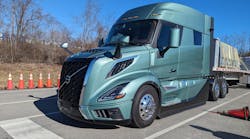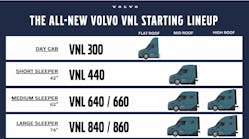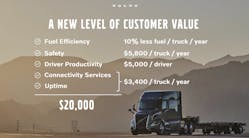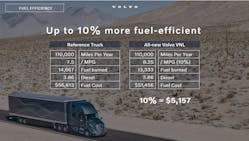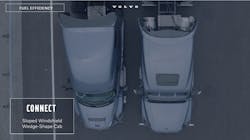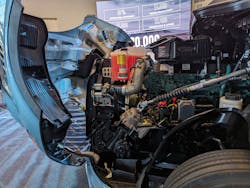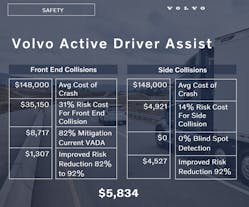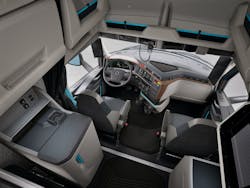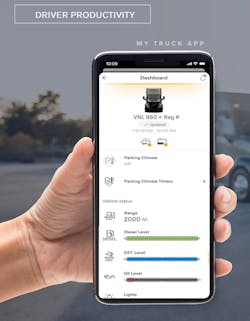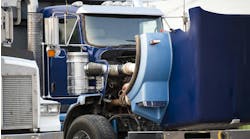DUBLIN, Virginia—Efficiency has become one of the buzziest of buzzwords. While a big focus is on how efficiency can make trucking greener, Volvo Trucks North America leaders said the all-new Volvo VNL truck could help fleets save more green.
“We are confident that this truck will deliver customers a value of $20,000,” Magnus Koeck, VTNA VP of marketing and strategy, told industry media gathered at the Volvo Customer Center here in the Blue Ridge Mountains in southwestern Virginia.
It’s the first complete redesign of the OEM’s flagship Class 8 vehicle since the 1990s. Volvo testing of the new VNL, which Koeck said was created from a “white sheet paper,” has shown fuel efficiency improvements of more than 10%, which could be worth $5,000 to $6,000, based on the current diesel prices.
See also: New Volvo VNL sets sights on trucking's next decade
More annual savings come through the new Class 8 truck’s safety (which VTNA values at $5,800 per year), driver productivity ($5,000), connected services, and better uptime ($3,400). “We actually believe these are quite conservative numbers,” Koeck added.
The new VNL—available in six configurations from day cab to 74-in. sleeper—is still in pre-production. Serial production is expected to begin around April, with the first customer deliveries in the third quarter. While the global truckmaker does not list prices for its equipment, leaders said the newest North American truck is designed to provide fleets with a strong return on investment.
“We say ‘all-new’ for a reason,” Koeck said. “Ninety percent is new. This platform was developed in North America for North American prerequisites by North American engineers. And we’re also building them here.”
Months before VTNA unveiled the new VNL to the market during a virtual event last month, the OEM brought in more than 100 of its top fleet customers to show off the prototypes and present the potential operating cost savings the VNL could offer.
“When we had these fleets in here last September, we talked about this number,” Chris Stadler, VTNA product market manager, said Tuesday. “After they saw it, they believed in it. But they also saw that with their own business, their own operations, that they could see more value than just $20,000.”
How Volvo created 10% in fuel efficiency in new VNL
To measure the 10% fuel savings, VTNA ran the new VNL against equipment with the same horsepower, rear-end ratio, and transmission, and it ran the same routes with the same drivers. The OEM showed off an overhead side-by-side comparison of the new VNL to the current model, which showed a stark shape contrast.
A lot of the fuel savings come from improved aerodynamics, including a wedge-shaped cab and sloped windshield. It also features a more aerodynamic roofline and improved Flow Below. Volvo engineers also designed the truck to use the wind to enhance operations and do things such as keep the engine cool without sacrificing horsepower.
“The more you can keep the engine cool and utilize that wind, the less the fan turns on,” according to Bobby Compton, VTNA product market manager. “There’s still a lot of horsepower used when a fan comes on. And any time that horsepower is not being used to drive the tires, it’s not creating value for our customers.”
See also: Ways to increase fuel efficiency through aerodynamics
Heavy-duty aerodynamic improvements can significantly reduce fleet operating costs and emissions by decreasing the energy needed to move vehicles down the road, according to a Tractor Aerodynamics Confidence Report by the North American Council for Freight Efficiency.
“Whatever powers the vehicle—whether traditional diesel, natural gas, propane, hydrogen, electricity, or combinations of those as hybrid vehicles—the efficiency of converting energy into motion always depends heavily on aerodynamic design,” according to the 2020 NACFE study.
This new VNL is also Volvo Trucks’ North American platform for future power systems, including battery-electric, fuel-cell electric, and renewables, as well as hydrogen, which is part of VTNA’s three-path approach to decarbonization.
But initially, the new VNL runs on diesel. The aerodynamic-focused redesign contributes about 70% of the fuel efficiency gains in the new VNL, according to Compton. The rest is under the hood.
The new VNL features the Volvo D13 engine and I-Shift transmission. Design enhancements to the D13 engine include a new wave piston with a shorter piston height and a longer connecting rod, smaller injector needle control valves, a variable vane oil pump, and improvements to the turbo compounding unit and turbocharger.
Volvo Trucks engineers enhanced the I-Shift to improve shift speeds up to 30%, which creates more efficiency. A truck transmission likely shifts gears thousands of times daily, Compton said. “If every time that transmission shifts gears, from eight to nine, first and second, whatever it may be—you go through neutral,” he explained. “Isn’t that just like idling? So, of course, we attacked it.”
Safety systems designed to protect lives and cut costs
“At Volvo, safety will always be about saving lives. Always,” Compton said. “The reality is there’s a cost. There’s a cost to safety.”
He said the average heavy-duty truck crash costs a fleet $148,000. VTNA said its safety technology could improve front-end collision risk reduction by 82% to 92% and improve side collisions by 92%. The OEM calculates this would amount to $5,834 annually per truck, in addition to more than $8,000 in risk-reducing technology already on Volvo Trucks.
See also: Research paves the way for ADAS in trucking
“Let’s say the potential is much more when you don’t have a safety system in your vehicle,” Stadler added.
The Volvo Active Driver Assist Plus with Pilot Assist showcased its active lane-centering capability in a successful demonstration on a three-mile test track on Tuesday. This enhancement is powered by the Volvo Dynamic Steering system, which offers benefits such as improved maneuvering, increased stability at various speeds, and enhanced adaptive corrections for crosswinds, uneven road surfaces, and emergencies, including tire failure.
The new pedestrian detection feature alerts the driver when a person walking or on a bicycle might be in the truck’s path or in a blind spot, activating frontal automatic emergency braking if needed.
Passive safety systems in the new Volvo VNL include the bonded and wrapped windshield. Along with its aerodynamic benefits, it improves visibility for drivers and reduces wind noise in the cab.
The new cab is designed to Volvo Trucks’ crash test standards. It will offer a side-curtain airbag, with options for driver-only or driver-and-passenger airbags, which VTNA said is a North American industry first. Cabs are constructed of high-strength steel to deflect the energy of a crash to reduce the chance of injury. Volvo Trucks’ flared frame rails also allow the powertrain to drop below the cab to protect the driver.
E-Call, a new safety feature, connects the driver to emergency services where cellular connectivity is available and provides precise location details. This automatically happens after a rollover crash or airbag deployment.
Creating a productive driving and living environment
With reinforced focus on keeping drivers and the motoring public safer, VTNA leaders anticipate the new VNL also helping fleets recruit and retain the next generation of truck drivers.
“The key question is: What makes a driver more productive?” Stadler asked. “The right tools. The right equipment. Maybe having a nice driving environment and a nice living environment.”
He said Volvo designers wanted to create a truck that drivers want to work in because it prioritizes comfort, efficiency, and safety while on the clock and provides a comfortable, homey place to rest when not driving.
See also: Prioritize driver health and safety
The cab includes amenities such as an optional folding bunk for dinette access, a streamlined control panel, enhanced insulation, a larger refrigerator, and versatile power options. The new VNL incorporates Volvo Trucks' idle management tool, the Volvo Parking Cooler, reducing emissions and lowering fuel costs during stops. This enhances the resting experience by eliminating noise and vibrations from idling.
“We have done so many enhancements in the driving, in the living, in the resting environment because we are also targeting the new generation of drivers,” Koeck said. “Not only do we know we have a new generation of customers, we have a new generation of drivers. And they are different compared to the old grandpa that was driving trucks before. They’re more tech-savvy, they’re more diverse, more female, different ethnicity. These younger innovators, early adopters also care about the environment and our planet.”
Connectivity improves uptime and efficiency
Volvo Trucks provides an optional Blue Service Contract managed by dealers. It uses real-time data from connected services to maximize the vehicle's availability. This enables proactive maintenance scheduling and remote updates to prevent unplanned downtime. Additionally, Volvo Trucks' Uptime Center remotely monitors the vehicle 24/7 and alerts drivers and dealers to critical issues.
With the Volvo MyTruck app, drivers can access truck data remotely to see estimated remaining fuel range, DEF and coolant levels, and get notifications about potential issues such as light malfunctions, low washer fluid levels, and other essential items so they can address them at rest breaks or in their pre-trip inspection. In addition, the MyTruck app allows drivers to schedule specific days and times to start the climate control so that the cabin temperature is at their preferred level when they arrive at their truck to begin their workday.
